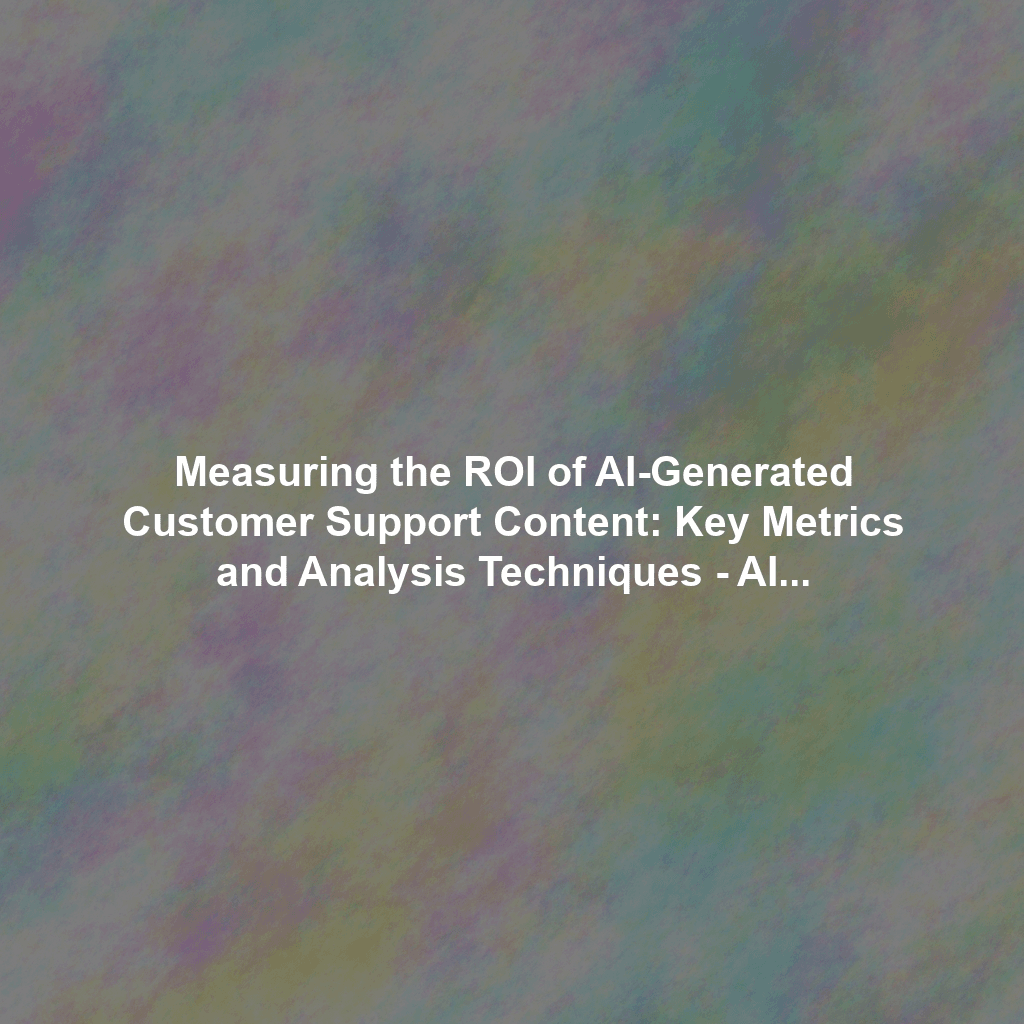In today’s fast-paced business environment, delivering exceptional customer support is paramount. AI-generated content for customer support automation is rapidly transforming how businesses interact with their customers, offering the promise of faster, more efficient, and cost-effective service. However, implementing these technologies requires careful consideration of return on investment (ROI). This article provides a comprehensive guide on how to effectively track and analyze the performance of AI-powered customer support initiatives, focusing on key metrics and analysis techniques to demonstrate tangible ROI.
Why Measure the ROI of AI-Generated Support Content?
Before diving into specific metrics, it’s crucial to understand why measuring ROI is so important. Simply put, it helps you justify the investment in AI, optimize your strategies, and demonstrate the value to stakeholders. Measuring ROI allows you to:
- Prove the Value: Show that your AI-driven customer support is contributing to the bottom line.
- Optimize Performance: Identify what’s working and what’s not, allowing for continuous improvement.
- Secure Future Investments: Gain buy-in for future AI initiatives by showcasing past successes.
- Compare Strategies: Evaluate different AI content strategies to determine which ones are most effective.
Key Metrics to Track for AI-Generated Customer Support Content
To accurately measure the ROI, you need to track the right metrics. Here are some of the most important ones:
Resolution Time
Resolution time, also known as Average Handle Time (AHT), is the time it takes to resolve a customer issue from initial contact to closure. AI-powered chatbots and knowledge bases can significantly reduce resolution time by providing instant answers and guiding customers through self-service solutions.
How to Measure: Track the average resolution time before and after implementing AI-generated content. A significant decrease indicates a positive impact.
Analysis Technique: Compare the AHT for issues handled by AI versus those handled by human agents. This will highlight the efficiency gains from AI.
Customer Satisfaction Scores (CSAT)
CSAT measures how satisfied customers are with their support experience. High CSAT scores indicate that your AI content is effectively addressing customer needs and providing a positive interaction.
How to Measure: Implement post-interaction surveys to gather feedback on customer satisfaction. Use a standardized CSAT scale (e.g., 1-5 or 1-10).
Analysis Technique: Segment CSAT scores based on whether the customer interacted with AI-generated content. Compare the scores to determine the impact of AI on customer satisfaction. Also, track trends over time to see if satisfaction improves as the AI learns and adapts.
Net Promoter Score (NPS)
NPS measures customer loyalty and their willingness to recommend your business to others. A higher NPS indicates that customers are not only satisfied but also advocates for your brand.
How to Measure: Use the standard NPS question: “On a scale of 0-10, how likely are you to recommend our company/product/service to a friend or colleague?”
Analysis Technique: Similar to CSAT, segment NPS scores based on interactions with AI-generated content. A positive correlation between AI usage and NPS suggests that AI is enhancing the customer experience and fostering loyalty.
Support Ticket Volume
AI-powered self-service solutions can deflect a significant portion of support tickets, reducing the workload on human agents and freeing them up to handle more complex issues.
How to Measure: Track the total number of support tickets before and after implementing AI. Also, monitor the percentage of tickets resolved by AI versus those requiring human intervention.
Analysis Technique: Calculate the cost savings associated with ticket deflection. Multiply the number of tickets deflected by the average cost per ticket to determine the financial impact of AI.
Cost Reduction
One of the most direct ways to demonstrate ROI is by showing a reduction in support costs. This can be achieved through reduced agent workload, improved efficiency, and decreased training expenses.
How to Measure: Track labor costs, training costs, and other expenses related to customer support before and after AI implementation.
Analysis Technique: Conduct a cost-benefit analysis to compare the costs of implementing and maintaining AI with the cost savings achieved. This will provide a clear picture of the financial ROI.
Attributing ROI to Specific AI Content Strategies
It’s important to understand which specific AI content strategies are driving the most value. Here’s how to attribute ROI effectively:
A/B Testing
Use A/B testing to compare different versions of AI-generated content. For example, test different chatbot scripts or knowledge base articles to see which ones perform better in terms of resolution time and customer satisfaction.
Content Analytics
Leverage analytics tools to track how customers interact with your AI-generated content. Monitor metrics such as page views, click-through rates, and time spent on page to identify what content is most engaging and effective.
Feedback Loops
Implement feedback mechanisms to gather insights from customers and agents on the effectiveness of AI content. Use this feedback to refine your content and improve its performance.
Tools for Measuring and Analyzing AI Content Performance
Several tools can help you track and analyze the performance of your AI-generated customer support content:
- CRM Systems: Platforms like Salesforce and Zendesk offer robust analytics and reporting features for tracking key metrics.
- Chatbot Analytics Platforms: Tools like Dialogflow and Botanalytics provide insights into chatbot performance and user behavior.
- Website Analytics Tools: Google Analytics and other similar tools can track how customers interact with AI-powered knowledge bases and help centers.
- Survey Platforms: SurveyMonkey and Qualtrics can be used to gather customer feedback and measure CSAT and NPS.
Conclusion
Measuring the ROI of AI-generated customer support content is essential for justifying investments, optimizing strategies, and demonstrating value. By tracking key metrics such as resolution time, CSAT, NPS, and support ticket volume, and by using effective analysis techniques, you can gain a clear understanding of the impact of AI on your customer support operations. By continuously monitoring and analyzing these metrics, businesses can refine their AI content strategies and maximize their return on investment, leading to improved customer satisfaction, reduced costs, and a more efficient support system. The insights gained will allow for a data-driven approach to improve customer experiences using AI-powered solutions.
 Skip to content
Skip to content

